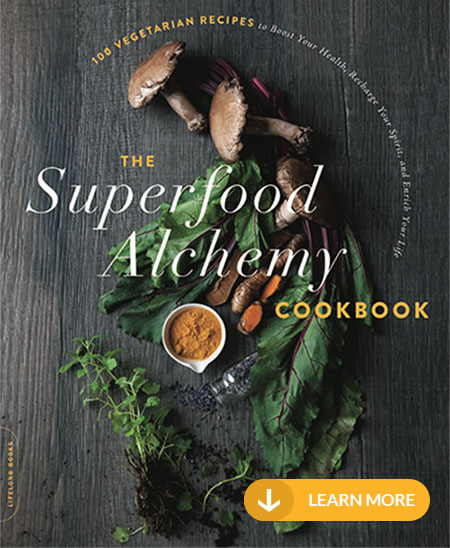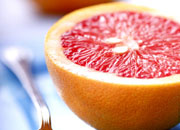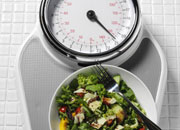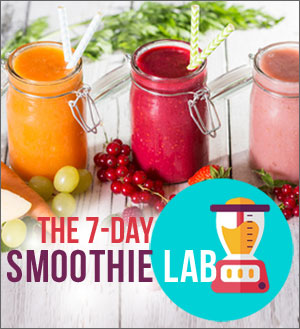 I recently did a fridge makeover with AOL, working with a lovely family to show them how to lighten up their fridge and make healthier choices.
I recently did a fridge makeover with AOL, working with a lovely family to show them how to lighten up their fridge and make healthier choices.
A few viewers wrote in with questions about 2% milk vs. skim and why I tell families to make the swap. My recommendation mainly has to do with saturated fat, that we know is hazardous to heart health because they easier clog arteries.
Milk is a staple in many households, something families drink at least once a day or more. So let’s take a look to see how an 8-ounce glass of 2% milk stacks up to skim.
- One 8-ounce glass of 2% milk has 5 grams of fat, 3 of which are saturated, 130 calories
- One 8-ounce glass of skim has 0 grams of fat, 110 calories
Might not sound too bad right? But nutritionists say to stay under 20 grams of saturated fat per day, so let’s add this simple lunch to your glass of 2%, after all milk isn’t the only potential source for saturated fat:
1 grilled cheese sandwich with two slices of American cheese cooked with one tablespoon of butter
That’s 21 grams of fat, 13 of which are saturated – so that means in just one meal you’re up to 16 grams, doesn’t leave much space for enjoying that slice of pizza with salad later or a cup of creamy broccoli soup.
What about 2% or full fat milk for kids? Lots of parents have heard that fat is necessary for health brain function for growing children and that is true. However, most nutritionists and doctors now say you can switch your toddler to nonfat or 1% milk to scale back on high fat levels that they no longer need after the age of two.
Related Posts
- Not a fan of milk but looking for extra calcium? Try adding more broccoli to your dinner plate.
- The Today Show nutritionist, Joy Bauer discusses 7 Mistakes to Avoid While Feeding You Kids.
- Which is better, fruit or juice?


 Are you ready to look better, feel more energized, and get back that youthful feeling you remember having as a kid? I can help you on a journey that will change the way you eat — for good. My
Are you ready to look better, feel more energized, and get back that youthful feeling you remember having as a kid? I can help you on a journey that will change the way you eat — for good. My 














 As a healthy cooking expert, health coach and TV host,
As a healthy cooking expert, health coach and TV host, 



You talk about fat in skim versus whole milk, but what about sugar? Is it true that the lower the fat content in milk, the higher the level of sugar?
Hi Sharon!
Yes that is true, the milk sugars go up slightly by 4 grams per cup for skim compared to whole milk, but the calories drop by 40 when you choose skim. However, we know for certain that the saturated fats found in whole dairy products like whole milk can raise your blood cholesterol, so it’s about making the best choice between the two. Skim milk is a great low-cal way to get your vitamin D, protein, and calcium, so I think it’s a pretty fair trade off.
High cholesterol runs in my family and I have been trying to get themto switch to skim milk for awhile now. But everyone complains about its “watery” consistency. Although, i have successfully convinced most members to swap to 1 I’m curious to know how 1% stacks up to skim? Is it a relatively fair trade or is skim still significantly better?
Yet the vitamin A and D in skim milk are added back in and are not absorbed as well especially since they are fat soluble.
True but remember that this is a question of good fats vs bad. If you’re concerned about this you can crunch on a few fat rich nuts (nuts contain the good kinds of fat, mono and polyunsaturated) with your cup of skim or add some unsweetened cocoa powder with a teaspoon of sugar. The point to going for skim- is that full fat and 2% milk contain high levels of saturated fat (or the “bad” kinds of fat) while skim milk still has nutrients minus the saturated fat. Now nuts contain mostly the “good” kinds of fat and would help with absorption.
The saturated fat in whole milk does indeed raise total cholesterol and LDL — but it also raises protective HDL. And while there is a lot of controvery and debate about whether LDL cholesterol is a serious risk factor for cardiovascular disease (CVD), researchers are unanymous in their agreement that HDL is protective against it — and that it is far healthier to have high HDL than low LDL. Furthermore, no major study has ever been able to show that a low-fat diet reduces the incidence of CVD or mortality from it (and this includes the really big studies such as MRFIT, WHI, and the Nurses Health Study). Saturated fat has taken the rap for causing CVD for more thare six decades no, but the link is spurious and unproven. A more likely culprit is the massive amouint of sugar and refined carbs in our diet since the 1950s, when heart disease rates first started to spike. Mankind evolved on a high-fat diet (especially saturated fat). At he turn of the last centry, when heart disease and heart attack were practically non-existent, our population consumed whole fat dairy products exclusively, ate lots of meat, and even cooked with lard. So-called “modern” low-fat dietary advice has given us co-epidemics of heart disease, Type 2 diabetes, and obesity. “Low-fat living” appears to be prescription widespread disease. Jim Healthy
Thanks for this Jim Healthy, great stuff! Thanks so much for sharing, very interesting indeed – but to set the record straight, I do not subscribe to a “low-fat” diet, I’m only saying to monitor saturated fat intake. The average healthy woman on a 2000 calorie diet a day is looking for 50 to 60 grams of fat daily– but mono and polyunsaturated of course. But I do agree with you on the problem of overall calorie intake, sugar, and processed carbs.
One thing I will say about your comment on LDL and primitive cultures– or even Americans 80 years ago—it’s not really an accurate comparison to what is happening today. Our lifestyles were totally different back then, highly physical and active along with much smaller portion sizes, and a lot less processed foods—also they still had grass fed animals which is another factor to consider. So in other words the foods that were high in saturated fat like dairy and meat had a different quality back in the day, and they were eating a whole lot less of them.
Also LDL can be lowered through rigorous physical activity (only if it’s on a regular basis) and back in the day the average person did a lot more physical labor, I would estimate 4 to 5 hours more than they do today. Just speaking with my Granny, when she was a little girl during the depression the women did laundry but hand, ironed clothing and bed sheets at least 1 hour daily, tended a garden and cooked every single meal by hand, including making their own bread. That’s drastically different compared to how much physical energy it takes not to do laundry now, push a grocery cart, or order in a meal.
I wold love to hear what you think about the link between saturated fat and cortisol release?
Jim, one thing we are seeing at pt is that some people do well with no milk at all. All depends on how they respond personally.
Additionally, an increase in fats like avocado seems to be correlated with more energy.
What this means, I think, is that the debate about fat is a lot more complex than just the high fat vs low fat one.
Kinds of fat matter, as does how that relates to the amount of sugar in the diet, micronutrient levels etc.
Habib
This is old (and dangerous) thinking. Kids absolutely need the whole milk, and adults would do better to have a few more calories and saturated fat grams than the sugar. Also, I drink more of the skim trying to fill up. That’s more carbs I don’t need………..I think that drinking at least 1% is much healthier.
Depends which “kids” you are talking about. Children up to the age of 3 should have full fat dairy, after that nutritionists say to switch to low fat milk 1% or skim. I wrote this blog with toddlers and adults in mind, but thanks for writing in!
What about the notion that the process of removing fat from 2% to skim milk actually causes the nutrients in the milk to warp into something that can actually cause heart disease? Does anyone know of any studies to this effect?
I think it is important to add that reduced fat milk has most of its omega 3 removed while much of the omega 6 is left intact. It is very important to have an omega 3 : omega 6 ratio as close to 1:1 as possible. A high intake of omega 6 polyunsaturated fatty acid along with a low intake of omega 3 PUFA is responsible for many different modern health problems. In a previous comment it was recommended to eat nuts along with reduced fat milk. However, the most popular nuts (peanuts, almonds, cashews, pistachios, hazelnuts, Brazil nuts) contain high amounts of omega 6 and almost no omega 3. Macadamia nuts are the wisest choice as the majority of its fat is monounsaturated, and the omega3:omega6 ratio is not unfavorable. The other nuts are still a good food to snack on (in moderation) despite their high amount of omega 6 fats as the truly dangerous source of omega 6 is refined vegetable oils. Corn,
Hey John, thanks for writing in! The info you’ve sited is correct, but keep in mind that we’re still talking about saturated fat here in full fat and 2% milk which is a big issue– and what I’m zeroing in on, so skim still is the better choice.
In terms of omega 3s- milk is not really a great source to begin with and it has to be grass fed cows that produce the milk for it to be high in omega 3s so I don’t list milk as a source normally. There are very few dairy brands country wide that are grass fed. It’s a hard to find product, more expensive although it does tastes world’s above the rest!!
So if you’re drinking a lot of full fat milk, (on top of cheese, fatty cuts of beef and pork) you’re still getting a lot of saturated fat which is a big issue for people who are pron to heart disease, weight issues, and high cholesterol.
As for finding the best sources for omega 3 fatty acids, fish oil pills, fatty fish, and sardines are the great sources, and they are absorbed the best by our bodies compared to vegetal sources.
Hi again, Jennifer! Let me just add some stats to the sat-fat debate. This from Gary Taubes, Good Calories, Bad Calories — p. 13: “From the end of World War II, when the USDA statistics become more reliable, to the late 1960s, while coronary heart-disease mortality rates supposedly soared, per-capita consumption of whole milk dropped steadily, and the use of cream was cut by half. We ate dramatically less lard (13 pounds per person per year, compared with 7 pounds) and less butter (8.5 pounds versus 4) and more margarine (4.5 pounds versus 9 pounds), vegetable shortening (9.5 pounds versus 17 pounds), and salad and cooking oils (7 pounds versus 18 pounds). As a result, during the worst decades of the heart-disease “epidemic,” vegetable-fat consumption per capita in America doubled (from 28 pounds in the years 1947-49 to 55 pounds in 1976), while the average consumption of all animal fat (including the fat in meat, eggs, and dairy products) dropped from 84 pounds to 71. And so the increase in total fat consumption, to which Ancel Keys and others attributed the “epidemic” of heart disease, paralleled not only increased consumption of vegetables and citrus fruit, but of vegetable fats, which were considered heart-healthy, and a decreased consumption of animal fats.”
From “What If Bad Fat Is Actually Good For You?” featured in Men’s Health (October 10, 2007): “Why do doctors tell us that diets low in saturated fat protect against heart disease? The fact is, they don’t. In 2000, the Cochrane Collaboration conducted a “meta-analysis” of the scientific literature on these so-called cholesterol-lowering, low-saturated-fat diets. The researchers examined 27 studies involving more than 18,000 participants. Their published data states that diets low in saturated fats have no significant effect on mortality, or even on deaths due to heart attacks.”
Taubes again, from Good Calories, Bad Calories – p. 27: “…the Framingham Study wasn’t the only one that failed to reveal any correlation between the fat consumed and either cholesterol levels or heart disease. This was the case in virtually every study in which diet, cholesterol, and heart disease were compared within a single population, be it in Framingham, Puerto Rico, Honolulu, Chicago, Tecumseh, Michigan, Evans County, Georgia, or Israel.” (All of these studies failed to show a causal relationship between dietary fat, elevated cholesterol, and heart disease.) Indeed, it may surprise you to learn that over the past decades researchers have spent billions of tax dollars trying to prove the connection between saturated fat and heart disease, yet with the exception of four small, seriously-flawed trials, these studies have failed to provide any definitive proof.
And Taubes from Why We Get Fat – p. 182: “The most famous example of failed research attempts appeared in the early 70s when the National Heart, Lung, and Blood Institute spent $115 million on a huge, decade-long clinical trial to test its stubbornly-held belief that eating less saturated fat would curb heart disease. The study, known as the Multiple Risk Factor Intervention Trial (commonly referred to as “Mr. Fit”) failed to show that a single heart attack had been prevented. When the disappointing results were published in 1982, The Wall Street Journal headline announced: “Heart Attacks, a Test Collapses.
“You’d think this mistaken belief would have been put to rest with MRFIT. But stubborn opponents of saturated fat convinced the government to include the proposition in the $725 million clinical trial known as the Women’s Health Initiative (WHI), the largest and most expensive diet study ever conducted. The results, published in 2006, show that a diet low in total fat and saturated fat had no impact in reducing heart attack and stroke in some 20,000 women who had adhered to the regimen for an average of eight years.
“The incidence of heart disease and heart attacks didn’t decline as health official expected it would as a result of consuming less fat and saturated fat. This is documented in numerous studies, the latest of which appeared in The Journal of the American Medical Association in November 2009 by Elena Kuklina and her colleagues at the CDC.
Finally: There has since been published, in 2005, a 20-year follow-up to the Nurses’ Health Study. This report (Am J Epidemiol. 161:672-9) showed an even stronger unadjusted relationship between CHD and saturated fat intake. However, after multivariate adjustment for dietary and lifestyle confounders, there was no relationship whatsoever. In fact, the highest quintile of saturated fat intake had a 3% lower risk, though not statistically significant. The p value for the overall trend was 0.93 indicating almost certainty that any association is due to chance.”
My opinion: We’ve been sold a bill of goods on the so-called “dangers” of saturated fat – and their wholesale replacement by “heart healthy” polyunsaturated fats (PUFAs), which readily oxidized in the bloodstream and cause both inflammation and artery disease (plus an established link to some cancers), is the source of many of today’s health problems. There is plenty of evidence that low-fat mania (especially low sat-fat) was started by the corn industry to create more uses and profits for their crop, including corn oil, margarine (hydrogenated corn oil), and corn syrup (HFCS). Decades later, we now know the truth about these Frankenfoods and the damage they have done to our health.
Dr. Joseph Mecola has recently published a history and recap of the sat-fat “controversy,” which I encourage you and your readers to visit at: http://articles.mercola.com/sites/articles/archive/2012/05/31/coconut-oil-for-healthy-heart.aspx. You might also be interested in my perspective in my editorial last week at: http://myhealingkitchen.com/featured-articles/should-doctors-give-you-nutritional-advice/. Jim H.
I have to say that I drink whole fat milk, and use real dairy butter. My cholesterol and lipid levels are in the normal range. My husband does not use dairy products at all, and instead uses nut, soy, or rice milks has elevated levels. He is also about 5 times more active than I am.
YES – heredity plays a big role in cholesterol as well, and in some cases not even diet can change that as we found with my uncle. That’s why it’s important to get your check ups and eat right, thanks for sharing!
I notice that you didn’t even bother to respond to “Jim Healthy,” probably because you can’t back up your claim that 2% is better for you. Fat is not what makes us fat. You even say yourself you don’t subscribe to a low-fat diet. Sugar and carbs are what make us fat. Your ideas are outdated and not supported by new research into what is making human being fatter than ever. 2% and skim milk are higher in sugar than whole milk, and can actually make you fatter than drinking whole milk. Look up the new studies at Harvard.
Thanks for your comment. I did respond to Jim. Basically, the issue is not about good fats you find in nuts seeds olive oil- for me it has to due with saturated fat that is very prevalent in milk, butter and other whole fat 2% products. Studies still show that saturated fat raises blood cholesterol and it has a strong inflammatory effect, which can be an issue for heart patients.